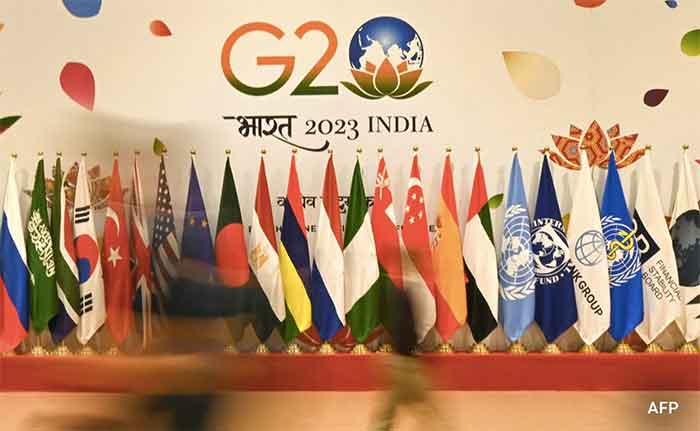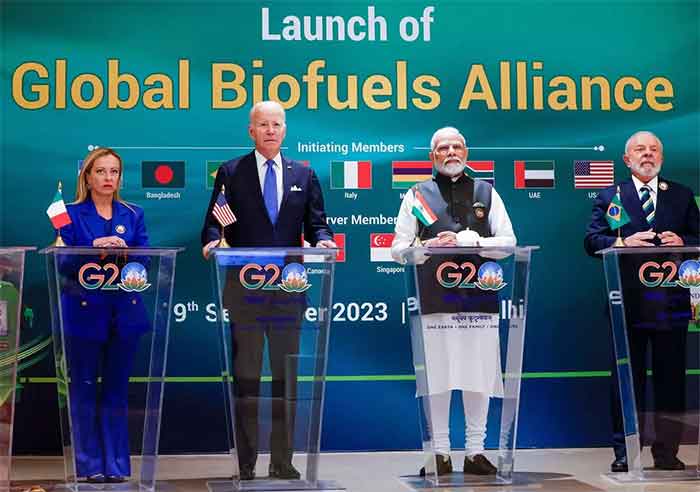
As part of the ongoing discussion between India and US on the sideline of the G20 meetings in 2023, both countries agreed to resolve their outstanding dispute at the World Trade Organization (WTO). From June 2023 to September 8, 2023 , there was lot off meeting and agreements. There was no comment or statement from Indian side, but Katherine Tai, United states Trade Representative issued statement in New York. Why India not issued the statement? It will attract lot of criticism to the so called ‘nationalist’ PM and his Party. As part of the agreement, India also agreed to reduce tariffs on certain U.S. products, including chickpeas, lentils, almonds, walnuts, apples, frozen chicken, frozen turkey, frozen duck, fresh blueberries and cranberries, frozen blueberries and cranberries, dried blueberries and cranberries, and processed blueberries and cranberries. This announcement comes as President Biden met with Prime Minister Narendra Modi on September 8th in New Delhi, India for the G20 Leaders’ Summit.
United States Trade Representative Katherine Tai has announced on September 8th that the “United States and India opens a new chapter of bilateral cooperation that will deepen the trade relationship between the United States and India”. However, all the farmers groups are very much worried about the deepening trade relations, because it means more duty reduction and market access for US agricultural products into India.
On August 18th, Samyukta Kisan Morcha (Non Political) had sent a letter to the Hon’ble Prime Minister and the Commerce minister, requesting “no more import duty reduction; rather increase the import duty”. We were concerned that the NDA government may surrender farmers’ interest to ensure G20 summit success.
On August 2017, the US began taxing imports from India. March 4, 2017, USA removed India from the U.S. Generalized System of Preferences (GSP), which had allowed it to export more than 3,000 items to the U.S. duty-free. As retaliation India increased the import duty on several agricultural imports from the US. India announced on June 15th that it would impose a 20 percent tariff on U.S. almonds and walnuts – along with 26 other products, including apples and lentils. Now the Government of India is reducing all these increased duties without getting any trade benefit for India.
On 19th July 2023, the government had already reduced the import duty from 70% to 50% on apple imports from the US. US apple is comparatively cheap due to high subsidies given to the US farmers. The statistics show how the increase of import duty had reduced apple imports from the US and had helped the Indian farmers. From January to June 15 2018, the US had shipped 7.8 million boxes (one box of 40 pound) apples. After increasing the import duty to 70%, around 2.6 million boxes of apples were imported into India between January to June 15 2019, which is 66.8% less than imports a year ago. This clearly indicates how the reduction in import duty in July 2023 to 50% would have already seriously impacted the apple growers in India.
The United States is the world’s largest producer and exporter of almonds accounting for more than 70% of world almond production and more than 80% of total world almond exports. Almonds was the top U.S. agricultural export to India with a value of $657 million in 2017. India is the largest importer of US almond leading the country to topple China and Spain to emerge as the world’s largest consumer of walnut in recent times. Between August 1st 2016 and May 31st 2017 (before increase import duty) California has shipped 201.8 million pounds of almonds to India, up 12% from a year ago, according to the Almond Board of California. The Indian increase in almond tariff amounts to about 20 cents a pound for shelled almonds and 4 cents a pound for unshelled almonds. This tariff increase stopped almost 70 percent of the import from US.
However, India also has large domestic production of walnuts being the second largest producer of Walnut with a production of 6,07,810 metric tons. United States with US$1.3 billion (37.6% of overall world exported walnuts) is the biggest exporter of walnut. India already had a 100 percent tariff on imported walnuts from all countries. Before the tariff increases, California shipped 15,857 tons of walnuts valued at $43.4 million to India during the 2016-17 seasons. After the increase, imports from the US fell significantly to 11,539 tons valued at $39.2 million during the 2017-18 seasons. This had significantly helped Indian walnut growers.
But the current tariff reduction will affect the apple, almond and walnut farmers in India. If India stops import of apple almond and walnut it will largely benefit the Himalayan states of India; Jammu & Kashmir, Uttarakhand and Himachal Pradesh. We can increase the farmers’ income considerably by controlling the import from US. All these states are now mainly depending on income from tourism sector. Further development of tourism in these highly ecologically sensitive areas is disastrous to these states. It is absolutely critical for these states to concentrate on cultivation and exports of of high value agricultural products like apple, almond and walnut. Consumption of all these products is sky-rocketing in India with the increase of income of middle class which promises a fast growing market opportunity for Indian farmers. Reducing import duty at this point will punish these states and their farmers and rob them of a market opportunity they desperately need.
The United States is a key global producer and exporter of chickpeas and lentils. In 2017, the United States accounted for about 11 percent of total global exports by volume and ranked third in total shipments. India increased the import duty of pulses in June 16, 2019 to 50 percent for lentils and 70 percent for chickpeas. Along with increased support price for pulses and more government procurement, farmers started growing more pulses and we reached full self-sufficiency in 2018. Production of pulses reached 23.13 million MT In 2016-17 and 25.42 million MT in 2017-18. The total consumption of pulses in India is estimated at around 23 million MT. The current import duty reduction will lead to the erosion of self-sufficiency and expose it to the vagaries of global markets.
Meat import from US is a big issue for Indian farmers. On January 10th 2022, India allowed pork import from USA. US is the second largest exporter pork, the second largest exporter of chicken, and the second largest exporter of chicken egg. U.S. poultry and egg exports in 2022 set a record at $6.234 billion, up 12.4 per cent over 2021.
However, US Turkey exports in 2022 were 184,837 metric tons, down 25.6 per cent from 2021 while export value was $641.6 million, down 3.6 per cent. The decrease in export volume is due largely to HPAI detections in important turkey-producing states such as Minnesota, Indiana, and North Carolina. More than 9.44 million commercial turkey meat birds were affected by the end of December 2022. U.S. turkey production in 2022 was 2.351 million metric tons, down 6.1 percent from the previous year. US is desperately looking to increase its turkey exports and by allowing turkey import, India is solving US’s turkey export problem.
Duck is one of the most significant poultry species in India. It holds a significant position in terms of eggs and meat production. Indian duck rearing is done by nomadic tribes, landless farmers and marginal farmers. Duck rearing mainly takes place in West Bengal, Kerala, all north east states, Andhra Pradesh, Tamil Nadu, Uttar Pradesh, Bihar and Orissa etc. Allowing duck import will seriously affect the poor farmers in duck rearing across these states.
The US can dump chicken in India as global production is increasing and trade war with China has further reduced chicken prices in US. Now US want a market that can match with China, and US always targeted Indian market. India’s per capita meat consumption, according to Compound Livestock Feed Manufacturers Association, is set to grow to 5.98 kg by 2025 from 3.35 kg in 2017 with the population rising and income levels growing which represents a lucrative market for the US.
On September 8th 2023, the US statement declared that India and the US have resolved their seventh and final outstanding trade dispute over the import of poultry, including chicken and eggs from US, which was prohibited by India’s concern over avian influenza. The US had challenged the restrictions on imports of poultry and egg that India had in place on poultry imports at the WTO. In 2015, New Delhi lost the case and the WTO ruled that the import restrictions should be removed. By resolving the poultry issue, the US will dump those parts of the chicken that are not consumed within the US, which could be everything except for the fillet (main portion of the breast). The US consumers have a strong preference for consuming the fillet of the bird. Hence, the cost of production is covered by the price of the fillet. From the perspective of the US producer, all the rest is unimportant, and should be sold for a break-even amount. This means the fillet is indirectly subsidizing the production of the rest of the bird, since all other parts except the fillet can be sold at a price far below the production cost of the total bird. It is cost-friendly for US producers to dump their chicken parts abroad than to pay for disposal of the waste. Parts of the chicken are exported to developing countries. Some of the Chicken parts are converted to animal fodder which is also imported into India. In 2017 India imported Rs 155.70 crore of such animal fodder from US which increased to Rs 187.68 crore in 2018. India has not developed such a system of producing animal feed from meat waste. Chicken legs exports to developing countries is more profitable for US producers than animal feeds, as there is high demand for chicken legs. Another aspect of the cheap import is poultry feed in US is very cheap, because of subsidies to the corn and also because new GM corn and soybean is feeding in the poultry and animal farms. Crystalline protein [Cry1A(b)] corn variety is feeding in the poultry farms. However, research is still ongoing in the US about its health impacts. This corn is very cheap and therefore leads to weight increase. The crops grows within a short span of time growth and therefore reduces the cost of production. India does not give direct subsidies to maize so Indian maize costs $100 per tonne higher than the US maize. Moreover, the cost of production has increased by over 40 per cent on over the last year.
Such is the difference in costs, that even if India imposed a100 per cent import duty, imported chicken legs will still be cheap in India. The cost of production for chicken legs is estimated at around $700-800 per tonne in the US. With 100 per cent duty, it would still be available at $1,500-1,600 per tonne, while the cost of production of processed chicken in India is around $1,800 per tonne
Poultry sector is one of the top growing agricultural sector and is generating considerable income for rural farmers. Any impact on poultry will seriously in turn affect soybean and corn growers because poultry industry is the main consumers of corn and soy-meal. The total investment in poultry sector is more than 2,10,000 crore, and more than 70% of this figure is loan from banks. Any adverse impact on the poultry sector will therefore affect banking sector as well.
India was one of the major countries that led an alliance of developing countries group to fight on US subsidies. If India allows much easier import of subsidized US agricultural products, it is not only going back from earlier stand at WTO, it also a let-down of other developing countries who fought with India on US subsidies.
The NDA government had already kept import duty of wheat at zero percent for 2016 and 2017, Now also we are hearing about reduction of import duty of wheat. India has allowed imports of 1 lakh tonnes of maize during 2019-20 under the tariff rate quota (TRQ) system. India allowed 5 lakhs tonnes of maize under TRQ during 2020-21. From 2020 June, 10,000 tonnes of milk products with 15 percent import duty under TRQ was allowed. In September 2022, India reduced import duty to 5.5% for crude palm oil and soyabean oil and 12.5% for refined palm oil and soyabean oil. This increased liberalisation of several agricultural imports are already hitting Indian agricultural farming and farmers. Now, allowing market access and reducing import duty for above mentioned agricultural products from US will further increase this adverse impact. Interestingly the US is not having to make any compromises on its own trade policy.
This irrational policy shift will compromise the long-term development of the agricultural sector and the livelihood of farmers. Rather than reducing import duties to please developed countries, India should focus on designing a strong trade policy that increases tariffs and couples with domestic supportive policies to ensure a resilient, self-sufficient agricultural production and food security for all Indian citizens.
Farmers are demanding to increase import duty to save the farming from crisis. Here Narendra Modiji is reducing import duty and punishing farmers. The best is to call him and his party is ‘anti farmer and anti national’
K V Biju, National Coordinator, Rashtriya Kisan Mahasangh, Coordination committee members, Samyukta Kisan Morcha(N P)
Email: [email protected]















































